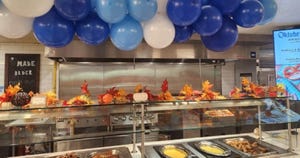
These innovative eateries are ones to watch.
Making 'local' a cornerstone of the cafeteria
Here's how Whitesboro Independent School District, FSD's July Foodservice Operation of the Month, builds student engagement as well as community catering sales.
July 13, 2021

Local produce is typically defined as sourced within 250 miles. At Whitesboro Independent School District in Texas, however, it’s more like 250 steps max.
The foodservice staff at Whitesboro’s four-school district works hard to make the cafeteria a fun and exciting place—and that includes its “tower gardens,” hydroponic systems with glowing lights that draw kids in to watch their future meals grow in real time.
“They’ve been sitting in class for hours, so we want the cafeteria to be a place not just where they get real nourishment but a place they’re excited to come to,” says Child Nutrition Director Alicia Tracy. “When we get them in, we get them eating good food.”
Making dining an event
It’s always a party at Whitesboro’s four cafeterias: Music over the speakers. Watermelons cut into fruit boats and cornucopias. A celebration of National Chocolate Day. A contest for students’ best taco sauce, with samples served by principals. Themed lunches like “movie night” with Harry Potter burgers, Trolls tots, Ratatouille veggie dippers and Olaf ices. A produce of the month program featuring watermelon radish or purple cauliflower.
And, of course, produce from those tower gardens. They were an instant hit when Tracy and her team added them to the cafeterias three years ago as part of their farm-to-school program. They now supply lettuces, herbs, tomatoes, squash and more, routinely fulfilling 100% of the needs for a full day’s serve of salads or burger fixings.
“A tower garden is most definitely a conversation starter,” Tracy says. “It looks a little alien with the lights, and the kids absolutely love running over to check out what’s going on. They’re a lot more apt to eat when they’re involved in the process, so we also have the home ec and cooking classes help with the planting, pollination and watering.”

Photo courtesy of Whitesboro ISD
These gardens also help Whitesboro meet its soft goal of serving 25% local produce, which fell to 10% in the last year because of COVID.
But even as the pandemic hurt the supply chain and many other aspects of foodservice, the crisis gave Whitesboro a major boost in one area: Catering sales are up an impressive 50%.
Catering to the community
Led by Sheila Johnston, the team’s catering program offers a lengthy menu for events serving 4 to 500 people. And Johnston’s open to creating whatever a customer desires for events like sports games, school banquets, proms and even weddings.
The team jumped on COVID-era opportunities like classroom catering—whipping up birthday treats since students could no longer bring in cupcakes—and providing food for end-of-year parties. A local daycare orders lunch twice a month, and the Chamber of Commerce is a frequent customer as well.
“We’re a small town, so word of mouth from the Chamber and our other customers really helps,” Johnston says. “If it’s not on our list, we are still open to the customer’s ideas. If it’s possible for us to make something, we will do it.”
That includes options like the street tacos the team made for a University Interscholastic League event. As visiting teachers chowed down on chicken tinga, beef barbacoa, pork carnitas and more, they asked Whitesboro teachers which restaurant the order came from —and were floored when the answer was in-house.
“Everybody, including our board, has been so supportive, ordering from us for these events and their board dinners,” Johnston says. “We know they have options, and they choose to order from us.”
That humble attitude keeps Whitesboro ISD’s foodservice team striving to delight their customers, whether it’s catering in the community or serving the students in their building.
The efforts are paying off, as the district has 90% diner participation at three out of its four schools. (Two of the district’s schools also take part in the Community Eligibility Provision, or CEP.)
And Tracy is always thinking about what’s coming up next. “Child nutrition can get a bad rap, but we’re trying to change that,” she says. “And you do that by creating fun, one day at a time.”
About the Author
You May Also Like




